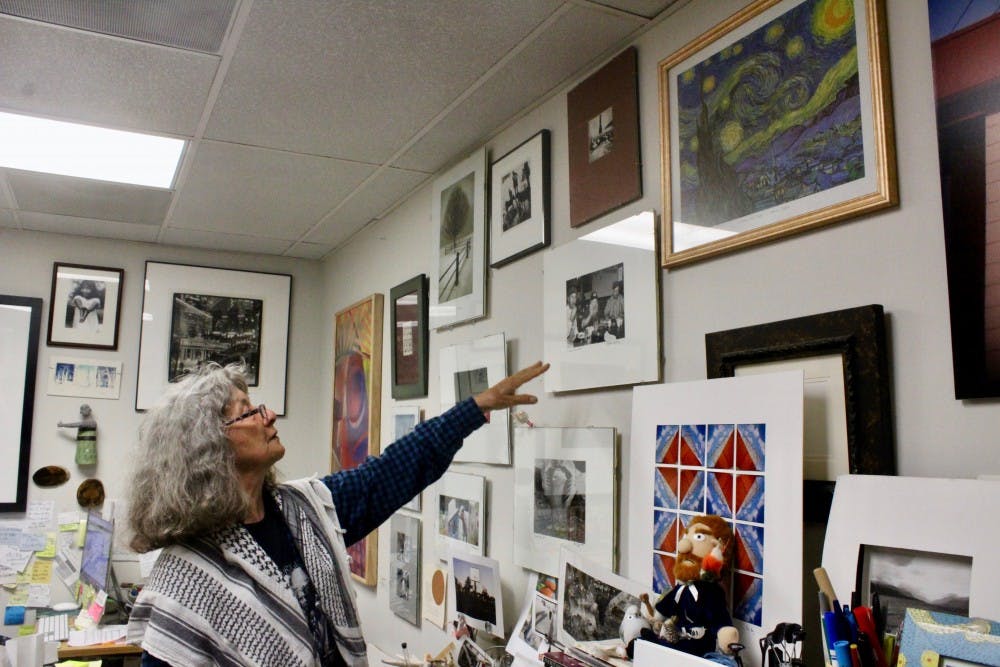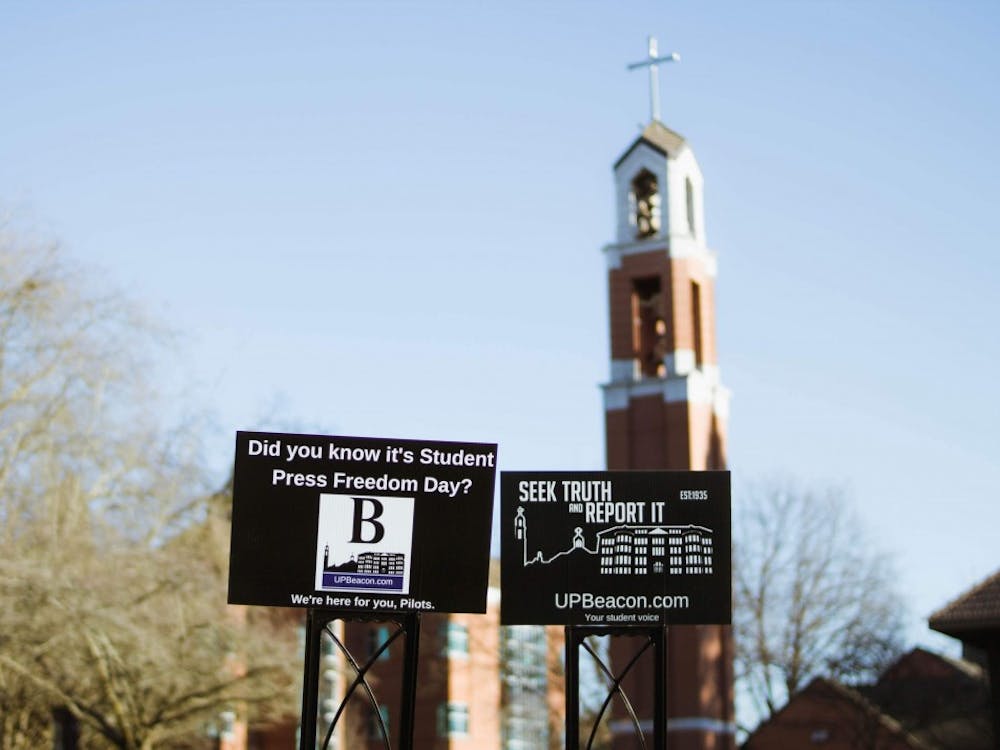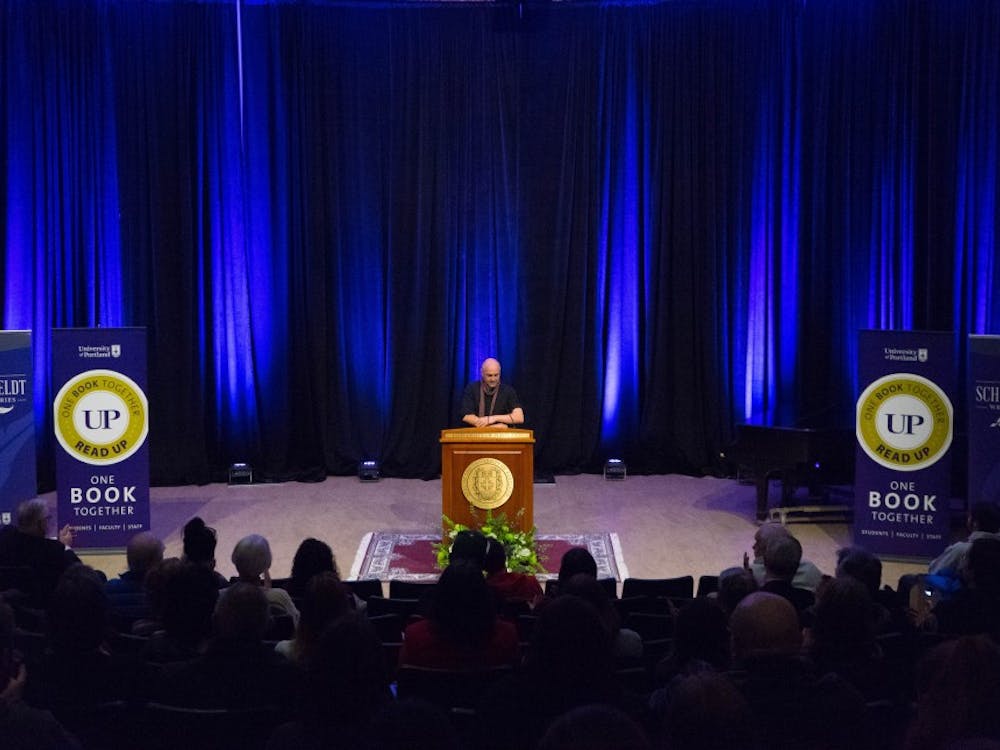Most students never take the time to look around their professor's offices. Despite the countless visits for office hours, the personal objects strewn about often go unnoticed. At the University of Portland, dozens of offices showcase a professor’s unique experiences and passions. From art pieces to 3-D printers to books, every office is different. The Beacon talked with four professors about their offices, highlighting their unique interests.
Click the i in the top left corner of each gallery for insight on each item.
Pat Bognar, BC 021
Bognar, adjunct professor of photography and the curator of the Buckley Center Gallery, describes her art-filled office as a dumping ground.
Her office, in the basement of Buckley, contains a dozen cameras, art pieces by her former students and colleagues and various Vincent van Gogh prints.
“It’s a mess, but people like it,” Bognar said. “People come in and say ‘I want to look’ because, you know, there is so much to see.”
One of the main reasons her office has accumulated so much stuff is because people will buy photo equipment and cameras at yard sales and donate it to her, however the majority of it she can’t use. She either donates the objects to Goodwill or puts them in a corner of her office.
“People give us cameras and darkroom equipment. There was even someone who called me and said, ‘I went to this estate sale and they had some darkroom equipment and I wanted to buy a few things,” Bognar said. “I got two enlargers from that experience. (People) just give us stuff and I have difficulty saying no.”
Bognar’s love for van Gogh started after she saw his self-portrait, which she has a print of in her office, in the Musée d'Orsay while she was living in Paris for 10 years. She was drawn to the portrait because of its red and blue shadows and the way his eyes would intensely glare at you wherever you were in the room.
Gregg Meyer, Shiley 304A
The first thing you notice when walking into engineering instructor Meyer’s office is the never-ending robotic-hum of his two 3-D printers.
Meyer’s favorite item in his office is his electron beam tree, which he made by loading a piece of plastic with electrons and then pricking it with a sharp object, causing the plastic to fracture. Meyer said that there are very few of them in the world because not many people have access to a multi-million dollar particle accelerator like he had while at the Stanford Linear Accelerator Center in his 20s, he said. Meyer estimated that there are only 100 pieces like the one in his office in the world.
When The Beacon met with Meyer, he was attempting to attach an electric scooter to a water cooler. It was nearly completed, however, he had 3-D printed the wrong size part to connect the scooter to the cooler. Meyer wasn’t discouraged, because most objects printed don’t work on the first try.
Rather, he seemed giddy to finish so he could have his students make their own electric ice-chests and have them race around the second floor of Shiley at Weekend on the Bluff, where he plans to have a joke at the visiting parents’ expense. The plan involves two pairs of identical twins and two different pairs of identical scooters.
“They will start at one end of Shiley where it will appear to be a race of two students,” Meyer said. “They will go racing down the main drag and round the corner at the far end of the building, but immediately after they round the corner (the other pair) will reappear around the last corner before the starting line ... Everyone will go how-in-the-heck did they do that and it will look like magic.”
One of the many unique objects Meyers has is what at first glance appears to be a blurry image etched into a piece of plastic that he made for fun in his maker space at home. When the plastic is held up to a light, it becomes incredibly sharp and detailed.
The picture is of Poppy Northcutt, the first female engineer to work in the control system at NASA. Her team designed the return to earth trajectory for the Apollo 8 mission, the first successful attempt to orbit around the Earth's moon and return to Earth.
“I’ve had my careers, I just teach for fun now,” Meyer said. “If I'm not at home in my own maker space, I'm here coming up with crazy ideas or crazy inventions.”
Michael Cameron, BC 445
To call professor of historical theology Michael Cameron’s office an ‘office’ would be a mischaracterization. It is closer to a library. Most of the books on his shelves are for reference.
Cameron’s office has a multitude of religious objects. Hanging above his desk is a cross of Jesus that is based off a 12th-century Byzantine crowned christ from Sicily. The cross is unique because Jesus is wearing a royal robe and a royal crown, emphasizing his kingship.
In the corner of his office is a framed picture of a painting from the Book of Kells that depicts the four gospels: Mathew, Mark, Luke and John.
Next to the picture of the gospels, Cameron has a painting of the influential humanist, Erasmus of Rotterdam. Erasmus was noted for his thoughts on human flourishing.
“(Erasmus) is an inspiration to me,” Cameron said. “He loved texts, he loved the greek of the New Testament and he was highly aware of the discipline of rhetoric … which is not only what you say, but how you say it.”
One of Cameron's favorite and most treasured items in his office is a framed picture of his wife that rests on a in the center of a bookshelf on the back wall.
“This (was) taken at the Gare du Nord in Paris, before she was about to go on a research trip and I was leaving her for a period of 9 weeks,” Cameron said. “I took that picture and developed it, because at the time you had to develop it, and brought it home and treasured it for 9 weeks until she got home. I look at that a lot.”
Laurie McLary, BC 201B
German professor and academic associate dean of the college of arts and sciences, Laurie McLary’s office is heavily influenced by two things: Austria and Georg Trakl.
One side of her office is filled with books in English and German. Most are reference or theory books. Some are a compilation of photographs from WWI.
The corner of her office has about a half-dozen books by or about McLary’s favorite poet: Georg Trakl. McLary was drawn to Trakl’s work because of how he was able to describe the underlying tensions of pre-WWI Salzburg.
“What he was writing about in his poetry for me helped me to see the city in a different way,” McLary said.
“I think a lot of people see Salzburg as being a super beautiful and super story-book city,” McLary said. “But Trakl grew up in it, so he was able to see the beauty in it, but also the other side, so there is a sort of tension and ambiguity in his work.”
McLary also has two first edition books from Trakl that she bought from an antique store in Vienna.
On a red cabinet in front of her desk, McLary has a framed painting from her daughter from when she was 9, inspired by the young adult book series, “Warriors.”
“At the top you can see symbols of different warrior clans,” McLary said. “I remember, in the day, this was something she would talk about non-stop”
On the right wall of her office, McLary proudly showcases her Oregon Professor of the year certificate, awarded to her in 2015 by the national Carnegie Foundation for the Advancement of Teaching and the International Council for the Advancement and Support of Education.
Neatly arranged on the side of McLary’s desk are three small bottles of ink and two fountain pens. She said she enjoys writing with these types of pens, which she picked up from her husband.
“(My office) feels like a haven, it is both social and contemplative,” McLary said. “I have a lot of people going in and out. If I am trying to work on something I can focus.”
William Seekamp is a reporter for The Beacon. He can be reached at seekamp22@up.edu.








